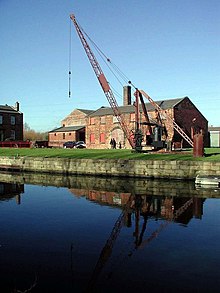
Thwaite Mills or Thwaite Watermill is an industrial heritage site in Leeds, West Yorkshire, England, on the River Aire and the Aire and Calder Navigation. It is a fully restored working water-powered mill built in 1823–25, harnessing the power of the river, and has been called "one of the best last remaining examples of a water-powered mill in Britain". The mill, the manager's house and three associated buildings are all grade II listed buildings. The site was open to the public as a museum operated by Leeds City Council until 1 April 2024.
History
The first known mill on the site was a fulling mill built in 1641, as part of the local industry of manufacturing woollen cloth. In 1823–25 the Aire and Calder Navigation company acquired the mill and redeveloped the site. Two new large waterwheels were built, and the site comprised the mill building, the manager's house, stables, workshop, warehouse and workers' cottages. The cottages were demolished in 1968, but the other buildings remain intact.
The mill was used for a range of purposes. The firm of W and E Joy used it to crush seeds for lubrication and lighting oil, and imported woods were crushed for the dyeing industry. The Horn family, who took over the mill in 1872, used it to crush flint and china stone for the pottery industry and to grind chalk to make "whiting" for industries ranging from pharmaceuticals to whitewash, then barytes for the paint industry, and until 1975 for the production of putty.
Set on an island between the River Aire and the Aire and Calder Navigation, the mill was as self-sufficient as its owners could make it. There were workshops, orchards, arable land and pasture, and the mill did not have an electricity supply until 1986, instead generating its own power from the two water wheels and a Marshall engine which was purchased to power the Raymond Mill in the 1930s.
In January 1975, the weir burst and the waterwheels stopped turning.
Preservation and museum
The Thwaite Mills Society was formed by volunteers in 1976 to preserve and restore this important site, and received financial support from the then West Yorkshire County Council. It was a registered charity, and ceased to exist by 2012.
In 1978 six buildings on the site were given Grade II listed building status: the mill, the manager's house, the warehouse, office, and drying floor, the bridge over the mill stream, the machine shop, and the stable.
The river weir was rebuilt, and the museum opened in 1990. It was run by Leeds City Council in partnership with Yorkshire Water.
As well as the functioning waterwheels, the mill contained a collection of machinery used at various times. The manager's house had been restored to reflect life there in the 1940s, and was visited self-guided. The museum site included a steam crane from 1946 and wildlife areas. A variety of special events was held at the museum.
The site is owned by the Canal & River Trust. It was leased by Leeds City Council who opened it to the public through Leeds Museums & Galleries until 1 April 2024. In February 2024 the council agreed to terminate its lease and close the museum, and the Canal & River Trust announced that they would not be able to continue operating the museum.
See also
References
- Leeds City Council. "Welcome to Thwaite Mills". Thwaite Mills. Archived from the original on 10 December 2009. Retrieved 30 October 2009.
- ^ Leeds City Council. "The Early Days". Thwaite Mills. Archived from the original on 12 August 2009. Retrieved 30 October 2009.
- Leeds City Council. "Thwaite Industry". Thwaite Mills. Archived from the original on 13 August 2009. Retrieved 30 October 2009.
- ^ "Thwaite Mills Leeds". VR Leeds. Archived from the original on 15 October 2008. Retrieved 30 October 2009.
- "The Thwaite Mills Society Charity 510771". register-of-charities.charitycommission.gov.uk. Charity Commission. Retrieved 12 April 2024.
27 January 2012: Removed (Ceased to exist)
- Historic England. "Thwaite Mill (1313492)". National Heritage List for England. Retrieved 12 April 2024.
- Historic England. "Thwaite House (1240993)". National Heritage List for England. Retrieved 12 April 2024.
- Historic England. "Warehouse, office, and drying floor to south-east of Thwaite Mill (1240992)". National Heritage List for England. Retrieved 12 April 2024.
- Historic England. "Bridge over mill stream to east of Thwaite Mill with retaining wall on south side of mill race (1135040)". National Heritage List for England. Retrieved 12 April 2024.
- Historic England. "Machine shop to east of Thwaite Mill (1135663)". National Heritage List for England. Retrieved 12 April 2024.
- Historic England. "Stable to north of machine shop to east of Thwaite Mill (1313186)". National Heritage List for England. Retrieved 12 April 2024.
- Leeds City Council. "A mill museum". Thwaite Mills. Archived from the original on 10 December 2009. Retrieved 30 October 2009.
- Leeds City Council. "Riverside Thwaite". Thwaite Mills. Archived from the original on 10 June 2011. Retrieved 30 October 2009.
- "Update on future of Thwaite Watermill". Leeds Museums & Galleries. Leeds City Council. 8 March 2024. Archived from the original on 28 March 2024. Retrieved 12 April 2024.
- "Leeds City Council proposes closure of Thwaite Watermill to cut costs". Museums + Heritage Advisor. 8 March 2024. Retrieved 12 April 2024.
- "Issue details – Closure of Thwaite Watermill and early lease termination". democracy.leeds.gov.uk. 7 March 2024. Retrieved 12 April 2024.
External links
53°46′34″N 1°30′14″W / 53.7762°N 1.5040°W / 53.7762; -1.5040
Categories: